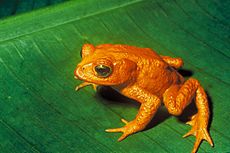Vulnerable species facts for kids
Quick facts for kids Conservation status
|
|
|---|---|
 |
|
| Extinct | |
|
|
| Threatened | |
|
|
| Lower Risk | |
|
|
|
Other categories |
|
|
|
|
Related topics
|
|
 Comparison of Red list classes above and NatureServe status below  |
|
A vulnerable species is a type of animal or plant that is likely to become endangered in the future. This means they are at risk of disappearing forever if things don't change. For them to survive, we need to remove the dangers they face. Also, their numbers need to grow, which means they need to have more babies or seeds.
The International Union for Conservation of Nature (IUCN) is a global group that keeps track of how many plants and animals are at risk. They have a special list called the IUCN Red List. Currently, there are 4,728 animals and 4,914 plants on this list that are considered vulnerable.
Contents
What Makes a Species Vulnerable?
A species becomes vulnerable when its population starts to shrink. This can happen for many reasons. For example, their homes (habitats) might be destroyed. This could be due to people building new things or cutting down forests.
Another reason is if they are hunted too much. Sometimes, new diseases can also affect a species. Climate change, which causes changes in weather patterns, can also make it hard for some species to survive.
When a species is vulnerable, it means there are not many of them left. If their numbers keep dropping, they will become endangered. After that, they could become extinct, meaning they would disappear completely from Earth.
Animals on the Vulnerable List
Many different animals are listed as vulnerable. These include mammals and birds. Scientists and conservationists work hard to protect these species. They try to understand what is threatening them and how to help them recover.
Mammals
Some mammals that are vulnerable include:
- Colombian weasel: A small, quick hunter found in parts of South America.
- Eastern spotted skunk: A small skunk known for its black and white spots.
- Marbled polecat: A type of weasel with a unique marbled fur pattern.
- Pygmy spotted skunk: Another small skunk species, even smaller than the Eastern spotted skunk.
- Fat-tailed dwarf lemur: A tiny lemur from Madagascar that stores fat in its tail.
Birds
Some birds that are vulnerable include:
- White-fronted ground dove: A type of dove that lives on the ground.
How We Can Help Vulnerable Species
Protecting vulnerable species is important for our planet. Every living thing plays a role in nature. When one species disappears, it can affect many others.
There are many ways people can help. Supporting conservation groups is one way. These groups work to protect habitats and rescue animals. We can also learn more about these animals and share what we know. Reducing pollution and being careful with our natural resources also makes a big difference.
See also
In Spanish: Especie vulnerable para niños

